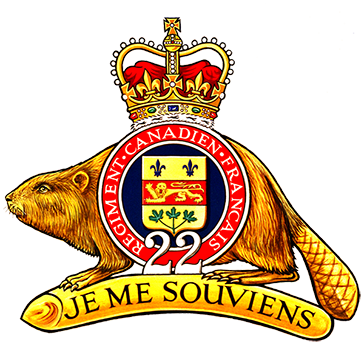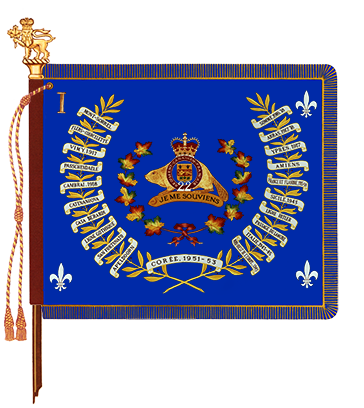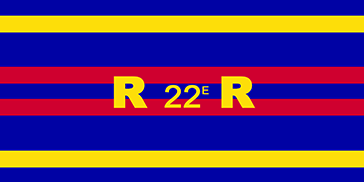Royal 22e Régiment
The official lineage of Royal 22e Régiment infantry regiment.

Colonel-in-Chief: Vacant
Badge
Description
A beaver couchant proper on a log Or bearing the motto JE ME SOUVIENS in letters Sable, overall a pellet charged with the 1868 arms of the province of Quebec (Or on a fess Gules between in chief two fleurs-de-lis Azure and in base a sprig of maple leaves Vert, a lion passant guardant Or) within an annulus Gules edged and inscribed REGIMENT CANADIEN FRANCAIS, surmounted at the base by the number 22 Argent and ensigned by the Royal Crown proper.
Symbolism
The beaver represents service to Canada, and the Crown, service to the Sovereign. The shield is the coat of arms granted to the province of Quebec in 1868. The fleurs-de-lis emphasize the French origin of the population, the lion on a red background recalls Quebec's ties to Great Britain and the sprig of three maple leaves is a symbol of Canada. The number "22" and the words "REGIMENT CANADIEN FRANCAIS" represent the 22nd Battalion of the Canadian Expeditionary Force of the First World War. "JE ME SOUVIENS" is the motto of the regiment and of the province of Quebec.
Motto
JE ME SOUVIENS (I remember)
Marches
Quick March
"Vive la Canadienne"
Slow March
"Marche Lente du Royal 22e Régiment" (also published under the title "La prière en famille")
Alliance
British Army
The Mercian Regiment and The Royal Welsh
Regimental colour

Camp flag

Battle honours
The War of 1812
DEFENCE OF CANADA – 1812-1815 – DÉFENSE DU CANADA; CHÂTEAUGUAY; CRYSLER’S FARM (the latter honour awarded in commemoration of the Canadian Fencible Infantry)
Honorary Distinction
The non-emblazonable honorary distinction DEFENCE OF CANADA – 1812-1815 – DÉFENSE DU CANADA
The First World War
MOUNT SORREL; SOMME, 1916, '18; Flers-Courcelette; Thiepval; Ancre Heights; ARRAS, 1917, '18; Vimy, 1917; Arleux; Scarpe, 1917, '18; HILL 70; YPRES, 1917; Passchendaele; AMIENS; HINDENBURG LINE; Canal du Nord; Cambrai, 1918; PURSUIT TO MONS; FRANCE AND FLANDERS, 1915-18.
The Second World War
LANDING IN SICILY; Valguarnera; ADRANO; Catenuova; SICILY, 1943; Landing at Reggio; Potenza; THE SANGRO; Casa Berardi; Torre Mucchio; CASSINO II; Gustav Line; LIRI VALLEY; Hitler Line; GOTHIC LINE; Borgo Santa Maria; LAMONE CROSSING; RIMINI LINE; San Martino-San Lorenzo; San Fortunato; Cesena; ITALY, 1943-1945; Apeldoorn; NORTH-WEST EUROPE, 1945.
United Nations Operations - Korea
KOREA, 1951-1953
South-West Asia
AFGHANISTAN
Lineage
This regiment originates on 4 June 1869 and incorporates both Regular and Reserve Force components.
The Royal 22e Régiment originated in Saint-Jean-sur-Richelieu, Quebec on 7 November 1914, when the '22nd (French Canadian) Battalion, CEF' was authorized to be formed.Footnote 1 It was redesignated: '22nd (French Canadian) "Overseas" Battalion, CEF' on 7 June 1915;Footnote 2 '22nd Regiment' on 1 April 1920.Footnote 3 'Royal 22nd Regiment' on 1 June 1921;Footnote 4 and 'Royal 22e Régiment' on 15 June 1928.Footnote 5 On 1 September 1954, it was amalgamated with 'Le Régiment de Châteauguay' (see below), retaining the same designation.Footnote 6 On 2 February 1956, it was amalgamated with 'Le Régiment de St. Hyacinthe' (see below), retaining the same designation.Footnote 7
Notes:
A Permanent Active Militia component was formed on 1 April 1920 (as above) and the Canadian Expeditionary Force component of the regiment was disbanded on 15 September 1920 (GO 149/20).
On 1 March 1946, the 'Royal 22e Régiment, CASF, CIC' was disbanded (GO 139/46) and the '2nd Battalion, Royal 22e Régiment, CIC' was redesignated 'Royal 22e Régiment, CIC' (GO 138/46). On 27 June 1946, the Royal 22e Régiment was embodied in the post-war Permanent Force (Active Force) (GO 158/46) (see operational history below).
On 7 August 1950, a '2nd Battalion, Royal 22e Régiment, RCIC' was authorized to be formed as an Active Force unit embodied in the Special Force (CAO 110-2, Supp Issue No. 210/50). On 14 July 1952, it ceased to be embodied in the Canadian Army Special Force (CAO 76-8, Pt 'B', Supp Issue No. 293/52).
On 9 August 1950, the Royal 22e Régiment was redesignated the 'Royal 22e Régiment, (1st Battalion), RCIC' (CAO 76-2, Supp Issue No. 193/50). On 1 February 1952, it was embodied in the Special Force (CAO 76-8, Pt 'B', Supp Issue No. 273/52). On 9 April 1952, it was redesignated '1st Battalion, Royal 22e Régiment, RCIC' (CAO 76-2, Pt 'B', Supp Issue No. 283/52) and on 10 June 1953, it ceased to be embodied in the Canadian Army Special Force (CAO 76-8, Pt 'B', Supp Issue No. 345/53).
On 9 December 1950, a '3rd Battalion, Royal 22e Régiment, RCIC' was authorized to be formed as an Active Force unit embodied in the Special Force (CAO 110-2, Supp Issue No. 210/50). On 1 November 1953, it ceased to be embodied in the Canadian Army Special Force (CAO 76-8, Pt 'B', Supp Issue No. 365/53)
On 1 September 1954, Les Fusiliers du St-Laurent were redesignated 'Les Fusiliers du St-Laurent (5th Battalion, Royal 22e Régiment)' (CAO 76-3, Pt 'B', Supp Issue No. 420/55). This was an affiliation not an amalgamation. Les Fusiliers du St-Laurent and the Royal 22e Régiment were separate and distinct regiments. This regiment was redesignated: 'Les Fusiliers du St-Laurent (5e Bataillon, Royal 22e Régiment)' on 9 November 1963 (CAO 76-3, Pt 'B', Supp Issue No. 765/64); and 'Les Fusiliers du St-Laurent' on 1 April 1968 (CFOO 68/11).
On 9 November 1963, the battalions, with the exception of the 4e Bataillon, were given French language battalion designations (CAO 76-2, 76-3, Pt 'B', Supp Issue No. 765/64). On 12 August 1977, all generic titles in the Canadian Forces, such as 'battalion', were made bilingual (Memorandum, DGBB (Director General Bilingualism and Biculturalism), 1901-1/1211-7-4, 12 Aug 77).
The 4th Battalion, Royal 22e Régiment (Châteauguay) originated in Beauharnois, Quebec on 4 June 1869, when the 'Voltigeurs-Canadiens of Beauharnois' were authorized to be formed.Footnote 8 It was redesignated: '64th Voltigeurs de Beauharnois' on 5 November 1869;Footnote 9 and '64th Regiment "Voltigeurs de Beauharnois"' on 8 May 1900.Footnote 10 On 1 May 1901, it was amalgamated with the '76th Regiment "Voltigeurs de Châteauguay"' (see below) and redesignated the '64th Regiment of Rifles "Voltigeurs de Chateauguay"'.Footnote 11 It was redesignated: '64th Chateauguay and Beauharnois Regiment' on 1 March 1902;Footnote 12 'Le Régiment Châteauguay et Beauharnois' on 29 March 1920;Footnote 13 'Le Régiment de Châteauguay' on 15 March 1921;Footnote 14 'Le Régiment de Châteauguay (Mitrailleuses)' on 15 December 1936;Footnote 15 '2nd (Reserve) Battalion, Le Régiment de Châteauguay (Mitrailleuses)' on 16 March 1942;Footnote 16 'Le Régiment de Châteauguay (Mitrailleuses)' on 1 June 1945;Footnote 17 'Le Régiment de Châteauguay' on 1 April 1946.Footnote 18 On 1 September 1954, it was amalgamated with the 'Royal 22e Régiment' and designated 'Le Régiment de Châteauguay (4th Battalion, Royal 22e Régiment)'.Footnote 19 It was redesignated: '4e Bataillon, Royal 22e Régiment (Châteauguay)' on 27 April 1956;Footnote 20 and, in English, '4th Battalion, Royal 22e Régiment (Châteauguay)' on 12 August 1977.Footnote 21
Notes:
The 64th Chateauguay and Beauharnois Regiment was disbanded for the purpose of reorganization on 1 June 1911 (GO 82/11) and reorganized on 18 September 1912 (GO 60/12). This change was administrative and does not affect the lineage of the regiment.
Upon redesignation as Le Régiment Châteauguay et Beauharnois on 29 March 1920 (see above), it was organized as a two battalion regiment with the 1st Battalion (206th Battalion, CEF) on the Non Permanent Active Militia order of battle, and the 2nd Battalion (no CEF designation) on the Reserve order of battle.
Le Régiment de Châteauguay was disbanded for the purpose of reorganization on 15 April 1921 and reorganized the same day (GO 157/21). This change was administrative and does not affect the lineage of the regiment.
On 15 May 1922, the 1st Battalion (206th Battalion, CEF) was redesignated the '1st Battalion' (GO 89/22).The reserve unit was disbanded on 14 December 1936 (GO 3/37).
The '76th Regiment "Voltigeurs de Châteauguay"' originated in Sainte-Martine, Quebec on 22 March 1872, when the '76th Battalion of Infantry or "Voltigeurs de Châteauguay"' was authorized to be formed.Footnote 22 It was redesignated: '76th Battalion of Rifles or "Voltigeurs de Châteauguay"' on 18 March 1881;Footnote 23 and '76th Regiment "Voltigeurs de Châteauguay"' on 8 May 1900.Footnote 24 On 1 May 1901, it was amalgamated with the '64th Regiment "Voltigeurs de Beauharnois"' and redesignated '64th Regiment of Rifles "Voltigeurs de Chateauguay"', as above.
The 6th Battalion, Royal 22e Régiment originated in Saint-Hyacinthe, Quebec on 24 March 1871, when the 'St. Hyacinthe Provisional Battalion of Infantry' was authorized to be formed.Footnote 25 It was redesignated: '84th "St. Hyacinthe" Battalion of Infantry' on 12 December 1879;Footnote 26 '84th St. Hyacinthe Regiment' on 8 May 1900;Footnote 27 'Le Régiment de St. Hyacinthe' on 29 March 1920;Footnote 28 '2nd (Reserve) Battalion, Le Régiment de St. Hyacinthe' on 3 January 1942;Footnote 29 and 'Le Régiment de St. Hyacinthe' on 14 January 1946.Footnote 30 On 2 February 1956, it was amalgamated with the 'Royal 22e Régiment' and redesignated the '6th Battalion, Royal 22e Régiment'.Footnote 31 It was redesignated: '6e Bataillon, Royal 22e Régiment' on 9 November 1963;Footnote 32 and, in English, '6th Battalion, Royal 22e Régiment' on 12 August 1977.Footnote 33
Notes:
Upon redesignation as Le Régiment de St. Hyacinthe on 29 March 1920 (see above), it was organized as a two battalion regiment with the 1st Battalion on the Non Permanent Active Militia order of battle, and the 2nd Battalion on the Reserve order of battle. The reserve unit was disbanded on 14 December 1936 (GO 3/37).
Le Régiment de St. Hyacinthe was disbanded for the purpose of reorganization on 1 March 1921 and reorganized the same day (GO 118/21). This change was administrative and does not affect the lineage of the regiment.
Perpetuations
‘7th Battalion, Select Embodied Militia’, ‘Les Chasseurs’, ‘Beauharnois, Beloeil, Boucherville, Chambly, Isle Jésus, St. Denis, St. Hyacinthe, St. Ours, and Verchères Divisions (1812-15)’
Headquarters Location
1st Battalion: Valcartier, Quebec
2nd Battalion: Quebec City, Quebec
3rd Battalion: Valcartier, Quebec
4th Battalion: Laval, Quebec
6th Battalion: Saint-Hyacinthe, Quebec
Operational history
Fenian Raids
The 64th Voltigeurs de Beauharnois were called out on active service from 9 to 29 April and from 24 to 31 May 1870. The battalion served on the Huntingdon frontier.Footnote 34
The First World War
Details of the 64th Châteauguay and Beauharnois Regiment were placed on active service on 6 August 1914 for local protective duty.Footnote 35
The 22nd Battalion, which was authorized on 7 November 1914 as the '22nd (French Canadian) Battalion, CEF',Footnote 36 embarked for Great Britain on 20 May 1915.Footnote 37 It disembarked in France on 15 September 1915, where it fought as part of the 5th Infantry Brigade, 2nd Canadian Division in France and Flanders until the end of the war.Footnote 38 The battalion was disbanded on 15 September 1920.Footnote 39
The Second World War
The Royal 22e Régiment, which was placed on active service on 1 September 1939 under the designation 'Royal 22e Régiment, CASF',Footnote 40 embarked for Great Britain on 9 December 1939.Footnote 41 The regiment landed in Sicily on 10 July 1943 and in Italy on 3 September 1943 as part of 3rd Brigade, 1st Canadian Infantry Division. On 16 March 1945, the regiment moved with the 1st Canadian Corps to North-West Europe, where it fought until the end of the war.Footnote 42 The overseas regiment was disbanded on 1 March 1946.Footnote 43
On 1 June 1945, a second Active Force component of the regiment was mobilized for service in the Pacific theatre of operations, under the designation '1st Canadian Infantry Battalion (Royal 22e Régiment), CASF'.Footnote 44 It was redesignated: '2nd Battalion (Royal 22e Régiment), CIC' on 2 September 1945;Footnote 45 and 'Royal 22e Régiment, CIC' on 1 March 1946.Footnote 46 On 27 June 1946, it was embodied in the Permanent Force.Footnote 47
Details of Le Régiment de Châteauguay (Mitrailleuses) were called out on service on 26 August 1939 and then placed on active service on 1 September 1939, under the designation 'Le Régiment de Châteauguay (Mitrailleuses), CASF (Details)', for local protection duties.Footnote 48 The details called out on active service were disbanded on 31 December 1940.Footnote 49
The regiment subsequently mobilized the '1st Battalion, Le Régiment de Châteauguay (Mitrailleuses), CASF' for active service on 18 March 1942.Footnote 50 It was redesignated: '1st Airfield Defence Battalion (Le Régiment de Châteauguay) (Mitrailleuses), CIC, CASF' on 19 July 1943;Footnote 51 '1st Airfield Defence Battalion (Le Régiment de Châteauguay), CIC, CASF' on 1 January 1944;Footnote 52 and '1st Battalion, Le Régiment de Châteauguay, CIC, CASF' on 1 September 1944.Footnote 53 This unit served in Canada in a home defence role as part of the 7th Canadian Division, and three companies of this unit served in Newfoundland.Footnote 54 On 10 January 1945, it embarked for Great Britain,Footnote 55 where it was disbanded on 18 January 1945 to provide reinforcements to the Canadian Army in the field.Footnote 56
Details from Le Régiment de St. Hyacinthe were called out on service on 26 August 1939 and then placed on active service on 1 September 1939, under the designation 'Le Régiment de St. Hyacinthe, CASF (Details)', for local protection duties.Footnote 57 The details called out on active service were disbanded on 31 December 1940.Footnote 58
The regiment subsequently mobilized the '1st Battalion, Le Régiment de St. Hyacinthe, CASF' for active service on 3 January 1942.Footnote 59 This unit served in Canada in a home defence role as part of Atlantic Command and in Newfoundland from April 1943 to September 1944.Footnote 60 The battalion was disbanded on 14 January 1946.Footnote 61
United Nations Operations - Korea
Three battalions of the Royal 22e Régiment served in the Republic of Korea as part of the 25th Canadian Infantry Brigade Group, 1st Commonwealth Division. The 2nd Battalion was the first to arrive in Korea (4 May 1951 to 24 April 1952), followed by the 1st Battalion (20 April 1952 to 21 April 1953) then the 3rd Battalion (16 April 1953 to the Armistice on 27 July 1953).Footnote 62
The Gulf War
'C' Company from the 1st Battalion served in Doha, Qatar providing airfield security from 24 December 1990 to the end of March 1991.Footnote 63
South-West Asia
Several Companies from the 1st, 2nd and 3rd Battalions served in Afghanistan from 2002 to 2014.Footnote 64
From 2002 to 2014, the 4th and 6th Battalion reinforced various CAF units deployed to Afghanistan.Footnote 65
Page details
- Date modified: